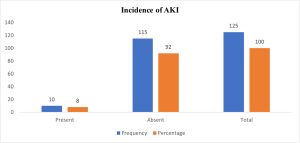
ABSTRACT
Background: Acute Kidney Injury (AKI) is a common condition and can happen due to drugs like Non-Steroidal Anti-Inflammatory Drugs (NSAIDs) and which can be reversible by discontinuing NSAIDs. This research aims to examine the risk factors and occurrence of AKI in individuals using NSAIDs, while also investigating the potential correlations between AKI and conditions such as hypertension, gout, and emergency medical situations. Materials and Methods: A comprehensive total of 125 patients were included based on specific criteria, encompassing both inclusion and exclusion parameters. The medical histories of these patients were meticulously reviewed, with relevant data duly documented, and concludingly subjected to statistical examination. Results: Among the 125 patients studied, 10 individuals were diagnosed with AKI, resulting in an incidence rate of 8%. Notably, 80% of these AKI cases were observed in the older age group (45-65 years), with 60% being male and 40% female, indicating a higher risk in male patients. Additionally, 40% of the AKI patients had a pre-existing condition of hypertension, which posed a higher susceptibility to AKI development. The diagnosis of AKI was based on laboratory parameter changes, particularly serum creatinine levels, and adhered to the KDIGO scale (Kidney Disease Improving Global Outcomes). Conclusion: Following the examination of NSAID users, it was concluded that the elderly population and individuals with a history of hypertension face the highest risk of developing AKI, leading to elevated serum creatinine levels. Additionally, male patients exhibited a higher frequency of AKI compared to their female counterparts. Notably, a significant number of patients were found to have taken Diclofenac for an extended duration, which correlated with increased serum creatinine levels and a potential link to AKI development. Consequently, Diclofenac usage warrants consideration as a drug that may contribute to the onset of AKI.
